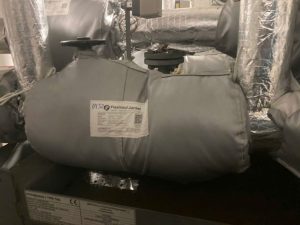Heat loss from industrial pipelines not only causes significant energy waste but also affects operational efficiency and workplace safety. Accurately identifying heat leak points is the first and most crucial step in implementing suitable insulation solutions to optimize costs and extend the system’s lifespan.
Let’s explore the 3 most effective methods to diagnose your piping system.
Why is Controlling Industrial Heat Loss Important?
In systems that transport steam, hot oil, or chemicals, heat loss leads to considerable waste. This not only increases the energy costs required to maintain the fluid’s temperature but also poses several risks:
- Workplace Safety: Overly hot pipe surfaces can cause burns to operating personnel.
- Production Efficiency: Unstable temperatures directly impact product quality and the stability of the entire process.
- Equipment Durability: Large temperature differentials can cause material expansion and contraction, reducing the lifespan of pipes and fittings.
Therefore, inspecting and identifying weak points in the insulation layer is an indispensable maintenance task.
3 Effective Methods for Identifying Heat Loss Locations
Depending on the system’s scale, complexity, and technical requirements, engineers can apply one or a combination of the following methods.
1. Thermal Imaging
This is considered the most modern, visual, and accurate method available today.
- How it works: A thermal camera is used to scan the entire surface of the system. The device captures thermal radiation and converts it into a color image (a heat map). Areas with hot colors (red, orange, yellow) indicate abnormally high temperatures, which are the exact locations of heat loss.
- Advantages:
- Fast & Comprehensive: Surveys large areas in a short time without direct contact.
- Visual & Accurate: The heat map provides clear data, making it easy to pinpoint areas and assess the severity.
- Safe: Inspections can be performed while the system is operating normally, without interrupting production.
- Applications: Ideal for periodic inspections of complex piping systems, valves, flanges, joints, and other equipment.
2. Using a Contact Thermometer or Infrared Thermometer
This method is more manual but is still very useful for checking specific points.
- How it works: A technician uses a contact thermometer or an infrared thermometer to measure the surface temperature at suspected points or critical locations like valves, elbows, tees, and flanges.
- Advantages:
- Low initial equipment cost.
- Easy to use, does not require specialized training.
- Disadvantages:
- Time-consuming and labor-intensive, making it difficult to cover the entire system.
- Easy to miss small heat loss points or those in hard-to-reach areas.
3. Data Analysis and Engineering Calculations
This method is based on heat transfer theory and the system’s operational parameters.
- How it works: Engineers collect data on temperature and pressure at the inlet and outlet of a pipe section. Based on material specifications, existing insulation, and fluid flow rate, they calculate the theoretical heat loss. If the actual results differ significantly from the theoretical calculations, that pipe section has an insulation problem.
- Advantages:
- Provides an overview of the entire system’s energy performance.
- Helps evaluate the effectiveness of the current insulation to plan for upgrades.
- Disadvantages:
- Does not identify the exact location of the heat leak.
- Requires high technical expertise and specialized calculation software.
Solutions After Identifying Heat Loss Points
After pinpointing the “hot spots,” the next step is to implement a suitable insulation solution. For complex locations that require frequent maintenance, such as valves, flanges, joints, and filters, a removable insulation jacket is the optimal choice.
Removable insulation jackets are custom-made for each piece of equipment, offering several outstanding benefits:
- High Insulation Efficiency: Significantly reduces heat loss, helping to save on energy costs.
- Flexibility: Easy to install and remove for equipment maintenance or repair without damaging the insulation material.
- Reusability: Can be reused many times, providing long-term economic benefits.
- Safety: Lowers surface temperatures, ensuring safety for operating personnel.
Investing in identifying and rectifying heat loss is not just about cutting costs; it’s also a crucial step toward operating a safer, more efficient, and sustainable plant.
Request consultation and quotation now!Frequently Asked Questions
Why is it necessary to control heat loss in a factory?
Controlling heat loss helps save energy costs, enhances workplace safety by reducing equipment surface temperatures, and ensures a more stable production process.
What is the most accurate method for identifying heat loss?
Thermal imaging with an infrared camera is the most accurate, fastest, and most comprehensive method, allowing the detection of all abnormal hot spots throughout the entire system without halting operations.
What is a removable insulation jacket and what are its benefits?
A removable insulation jacket is a custom-designed insulation cover that can be easily installed and removed from equipment like valves and flanges. Its main benefits are effective insulation, convenience for maintenance, and reusability.
When should a heat loss inspection be performed?
Businesses should conduct periodic inspections (e.g., annually), after major system changes, or when noticing a sudden, unexplained increase in energy costs.
Can I perform a small-scale heat loss check myself?
Yes, you can use an infrared thermometer to check easily accessible points. However, for a comprehensive and accurate assessment, hiring a professional service with specialized thermal cameras is recommended.










